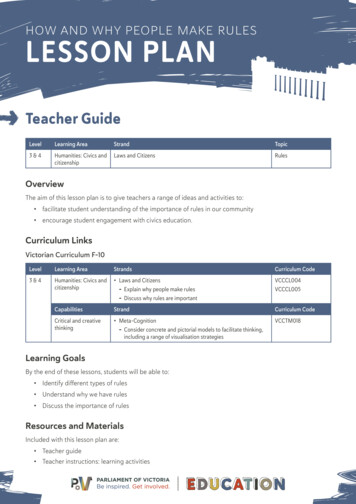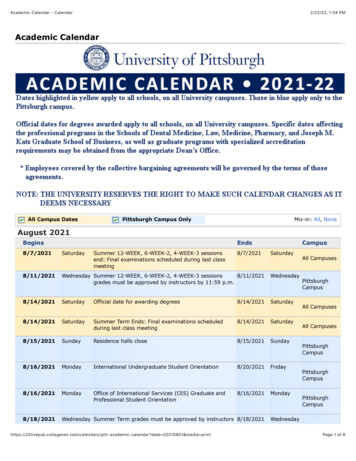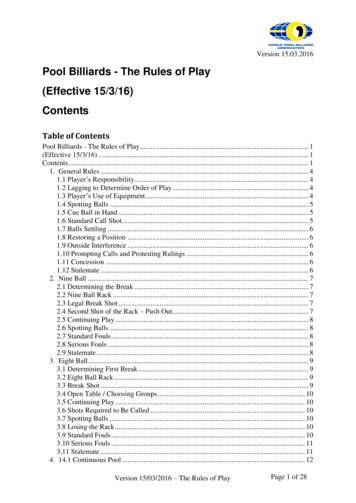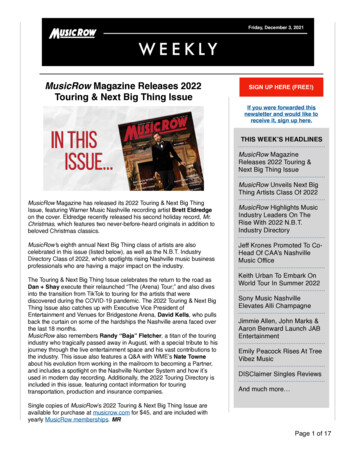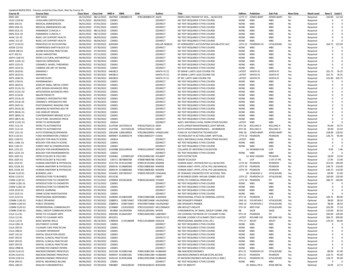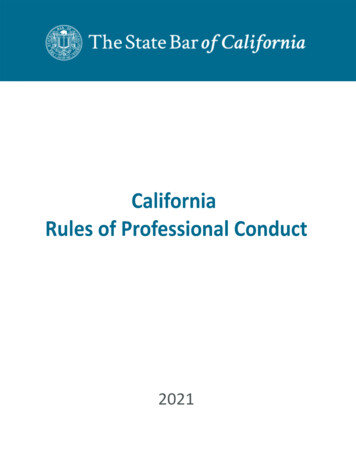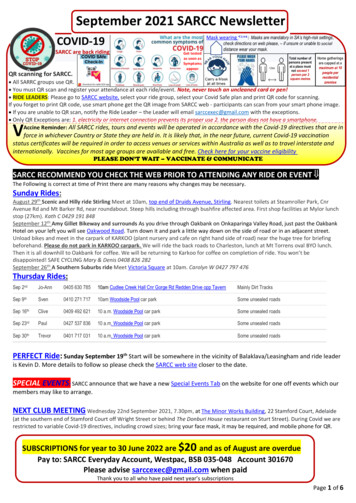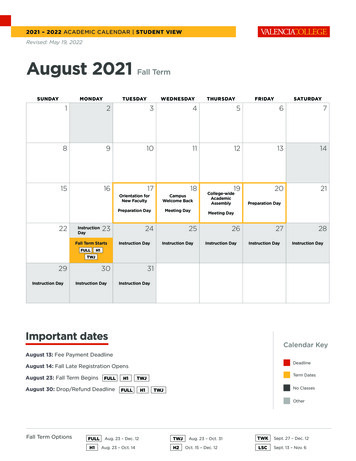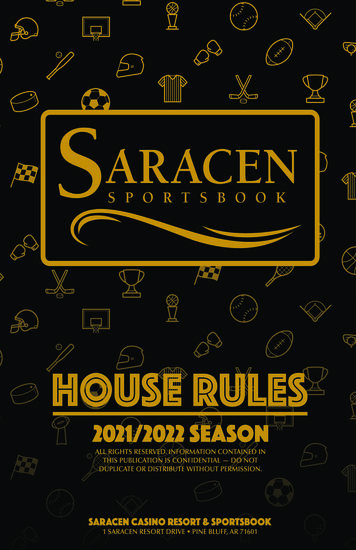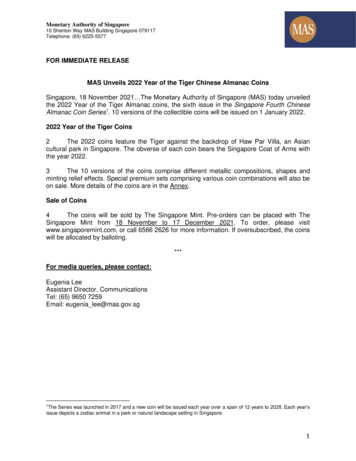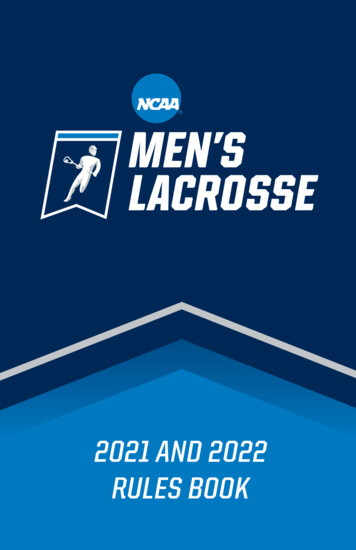
Transcription
men’slacrosse2021 AND 2022RULES BOOK
IFiLOSEI’LL RESPOND WITH RESPECT.Don’t undo my hard workwith poor sportsmanship.
2021 and 2022 NCAAMEN’S LACROSSE RULESAND INTERPRETATIONSNATIONAL COLLEGIATE ATHLETIC ASSOCIATION
[ISSN 0736-7775]THE NATIONAL COLLEGIATE ATHLETIC ASSOCIATIONP.O. BOX 6222INDIANAPOLIS, INDIANA 46206-6222317/917-6222NCAA.ORGOCTOBER 2020Manuscript Prepared By: William Scroggs, Secretary-Rules Editor, NCAA Men’s Lacrosse Rules Committee.Edited By: Andy Supergan, Assistant Director of Championships.NCAA, NCAA logo and NATIONAL COLLEGIATE ATHLETIC ASSOCIATION are registered marks of theAssociation and use in any manner is prohibited unless prior approval is obtained from the Association.COPYRIGHT, 1974, BY THE NATIONAL COLLEGIATE ATHLETIC ASSOCIATIONREPRINTED: 1975, 1976, 1977, 1978, 1979, 1980, 1981, 1982, 1983, 1984, 1985, 1986, 1987, 1988, 1989,1990, 1991, 1992, 1993, 1994, 1995, 1996, 1997, 1998, 1999, 2000, 2001, 2002, 2003, 2004, 2005, 2006, 2007,2008, 2010, 2012, 2014, 2016, 2018, 2020.PRINTED IN THE UNITED STATES OF AMERICA
Contents pageNCAA Men’s Lacrosse Rules Committee 4The Rules 5Major Rules Changes for 2021 and 2022 6Points of Emphasis 7Official NCAA Lacrosse Rules 8RULE 1—The Game, Field and Equipment 8RULE 2—Game Personnel 21RULE 3—Time Factors and Scoring 26RULE 4—Play of the Game 28RULE 5—Personal and Expulsion Fouls 55RULE 6—Technical Fouls 62RULE 7—Penalty Enforcement 73Official Lacrosse Signals 86Appendixes 90Appendix I—Crosse Inspection 90Appendix II—Records Keeping 93Appendix III—Lightning Guidelines 94Appendix IV—Ball and Crosse Specifications 95Appendix V—Table Crew Reference 97Appendix VI—Shot Clock Operator 100Appendix VII—Concussions 102Appendix VIII—Accommodations for Student-Athleteswith Disabilities 104Official Lacrosse Rules Index 105
NCAA Men’s Lacrosse RulesCommitteeThe chart below lists the members of the committee who voted on andapproved the rules included in this edition of the book. This information isbeing included for historical purposes.NameInstitutionTerm ExpirationJay ArtinianHofstra University8-31-22Jonathan BastiSacred Heart University8-31-20Jon HindHamilton College8-31-22Michael MurphyUniversity of Pennsylvania8-31-22Robert RandallNazareth College8-31-20Willie Scroggs*Secretary-Rules Editor8-31-22**Alex SmithSaint Michael’s College8-31-23Lars TiffanyUniversity of Virginia8-31-21Kevin WallaceEastern University8-31-21*Non-voting member**Eligible for reappointmentFor a complete and current listing of the NCAA Men’s Lacrosse RulesCommittee, please go to: ncaa.org/playingrules.The committee invites NCAA head coaches or other interested parties to submitrules-change proposals for the committee to consider at its annual meeting.Proposals may be submitted online at -proposal-form. All rules-change proposals are at the discretion ofthe committee.Those seeking interpretations of rules may contact:Willie ScroggsSecretary-Rules Editorwilliescroggs@unc.eduInterpretations and other rules information, are available at ncaa.org/playingrules.4
The RulesNCAA Men’s Lacrosse Rules and Interpretations have been designated aseither administrative rules or conduct rules. Typically, administrative rules arethose dealing with preparation for the game. The conduct rules are those thatdeal directly with the game itself. Some administrative rules (as indicated)may be altered by the mutual consent of the competing institutions. Othersare unalterable. No conduct rule may be changed by mutual consent. AllNCAA member institutions are required to conduct their intercollegiate gamesaccording to these rules.5
Major Rules Changesfor 2021 and 2022Each change or altered segment is identified in the rules by a screened background.The figures below refer to rule and section, respectively. In all Approved Rulings(A.R.), Team A is the offensive team and the home team and Team B is the defensiveand visiting team.Major Rules ChangesRuleDescription Page(s)4-3Defines stance and grip during the faceoff 284-3-b-3 Requires that at the start of the faceoff, the players takingthe faceoff may only have their feet, gloves and lacrossecrosse on the ground 294-3-b-9 Establishes that the player who has committed the third orsubsequent faceoff violations of the half shall serve the penalty. 304-15-c Establishes that the defensive team may call a timeoutduring dead-ball situations without having the shot clock reset 424-21-d Firmly establishes that offensive players cannot enter thegoal-mouth area at any time 476
Points of EmphasisHead Coach Pregame Meeting Head coach is required to meet with officials 30 minutes before thescheduled start of the game (see Rule 2-7). The pregame equipment certification by the head coach shall act as theteam warning.Sportsmanship Team Conduct/Decorum Pregame and Postgame Coaches are asked to monitor and discuss sportsmanship issues with theirteams; image of the sport is at risk. Player behavior during pregame warmups is a concern in some cases. Coaches and officials are to be respectful of the 5-yard buffer on eitherside of the midline that the committee previously established as a neutralarea druing pregame. Coaches are reminded to remain on the sidelines during live-ball play. The substitution area is only for coaches and for players who are aboutto substitute. Imminent substitution occurs when the exiting player iswithin 10 yards of the substitution box. The exiting player has the rightof way. Postgame, coaches shall be cognizant of teams crossing at the end of thegame, which can create issues.Crosse Inspections All crosses (including the faceoff player’s crosse) are subject to inspectionthroughout the duration of the game.Faceoff The overriding principle is for both players to play the ball. Players shall stand as they get into position for the faceoff. The crosse head and the gloved hands shall be touching the ground. Thehand closest to the throat shall be in a palm-up position. Quick clamps are permitted as per Rule 6-12.Goal Mouth An offensive player shall not enter the opposing team’s goal mouth at anytime (see Rule 4-21-d).Visible Shot Clock By the 2022 season, all men’s lacrosse institutions shall have two visibleshot clocks with the ability to be set and reset to two different times.7
RULE 1The Game, Fieldand EquipmentThe GameSECTION 1. Lacrosse is played by two teams of 10 players each. The purposeof each team is to score by causing the ball to enter the goal of its opponent andto prevent the other team from securing the ball and scoring. The ball is kept inplay by being carried, thrown or batted with the crosse, or rolled or kicked inany direction, subject to the restrictions described in the following rules.A.R. 1. A team that starts a game with fewer than 10 players, including thosein the penalty area, shall forfeit the game by a score of 1-0. When a teamdoes not appear for a game, that result shall be registered as a “no contest”rather than a forfeit.The FieldPlaying FieldSECTION 2. The playing field shall be rectangular, 110 yards long and60 yards wide. The boundaries of the field shall be marked with white orcontrasting-colored lines. The long sides of the field shall be designatedsidelines; the short sides shall be designated end lines. A bold white orcontrasting-colored line shall be marked through the center of the fieldperpendicular to the sidelines. This line shall be known as the center line andshall continue through any logos or other markings. All lines shall be not lessthan 2 inches wide nor more than 4 inches wide. The goal line including thegoal mouth shall be 2 inches wide. The center line shall be 4 inches wide.Out of bounds lines shall be measured from the inside edge of the line; fieldlines (e.g., midfield line, etc.) shall be measured from the center of the line.A.R. 2. All markings on the field shall conform to the “Men’s Lacrosse Fieldof Play” diagram in this book. Adherence to dimensions on the field diagramis mandatory unless participating institutions mutually agree to differentdimensions in writing, for those rules that are alterable.8
RULE 1 / The Game, Field and Equipment 9RULE 1 / THE GAME, FIELDANDEqUIPMENTMen’sLacrosseField9of PlayMen’s Lacrosse Field of Play5 ydsEND LINE10 ydsTHE GOAL LINE EXTENDED3 3 6 GOAL CREASESIDELINE15 yds9 RADIUSGOAL MOUTH6 RADIUS20 yds20 ydsBENCHESRESTRAINING LINETEAM AREACOACHES AREAATTACK AREAA 4" square line should beplaced in the middle of thecenter line in a contrasting color.SIDELINECOACHES AREA20 ydsDEFENSIVE AREASIDELINE35 ydsEND LINE6 yds60 ydsTIMER50 ydsBENCHES10 yds5 ydsTEAM AREA4" SQUARE10 ydsSUBSTITUTIONBOX110 yds4" WIDEWING AREAWING AREACENTER LINECOACHES20 yds120 ydsCOACHESLIMITLINE
10 RULE 1 / The Game, Field and Equipment5 ydsCOACHES AREATEAM AREACOACHES10 ydsSUBSTITUTIONBOXTIMERCOACHESCOACHES AREATEAM AREABENCHESBENCHES50 ydsA.R. 3. Officials arrive at the game site and notice that field markings inRule 1-2 do not conform to the “Lacrosse Field of Play” diagram or are ofincorrect dimensions. RULING: Officials notify Team A head coach. 1. Nopenalty will be assessed if corrections are made before designated game time;2. Technical foul (visiting team awarded ball) will be assessed if correctionsdelay the start of the game; 3. Three-minute full-time penalty (no faceoff )if Team A coach is unable or refuses to make corrections. Officials shouldnotify their district assigner.A.R. 4. After the scoring of a goal, Team A or B coach brings to the attentionof the officials that the crease, goal dimensions, etc., are in violation of therules. Can the goal be disallowed in accordance with Rules 1-2 through 1-15?RULING: No. It is assumed that, once the game has started, all physicalplaying conditions have been accepted by both teams and the officials, andthe game shall be played with these conditions, except for minor correctionssuch as a hole in net, etc.Goals and Goal LinesSECTION 3. A lacrosse goal shall form an opening that is 6 feet wide and 6 feethigh (inside measurements). Goals shall be constructed of 1-1/2 inch (outsidediameter 1.90 inches) metal pipe (recommended Nominal Pipe Size) and shallbe painted orange. All goals shall consist of two vertical posts joined by a rigidtop crossbar. These posts shall be 6 feet apart, and the top crossbar shall be 6feet from the ground.Lacrosse goals should be constructed in a manner such that when a ball entersthe goal mouth and is a goal, it shall not reenter the field of play. If in-groundgoals are used, the vertical posts shall be 7-1/2 feet in overall length and shallbe inserted into 1-1/2-foot-by-2-inch vertical sleeves that are inserted into theground, exposing 6 feet of vertical post above the ground. The sleeves shall becapped at the bottom, and the top of the sleeves shall be at ground level.
RULE 1 / The Game, Field and Equipment 11On fields where an in-ground goal is not used or on artificial-surface fields,the following goals are legal:a. Flat-iron goal (recommended for use on artificial-surface fields)—Each verticalpost shall be 6 feet long and shall be attached to a piece of flat iron at thebottom. The two flat irons, each attached to a vertical post, shall meet at apoint 7 feet back from the center of the goal. The maximum thickness of theflat iron shall be 1/2 inch, with no part of the flat iron extending into thegoal line. If a flat-iron goal is used on a grass field, it may be attached to theground with ground anchors.b. Obtuse-angle goal and 90-degree angle goal—Each vertical post shall be 6feet long and shall be attached to a ground pipe at the bottom. The groundpipe shall form an obtuse angle or a 90-degree angle with the goal lineimmediately behind the vertical post and then bend to extend to a point 7feet back from the center of the goal.A two-inch line shall be drawn between the goal posts to indicate the plane ofthe goal, and it shall be designated as the goal line. The net shall be consideredpart of the goal. The goals shall be centered between the sidelines and placed 15yards from each end line.Note: The home team is responsible for having legal goals. See Rule 1-2, A.R. 3 forpenalty procedures.Goal Crease/Goal MouthSECTION 4. Around each goal shall be a plainly marked circle known as thegoal crease. The area within the crease line shall not be painted. This circle shallbe marked by using the midpoint of the goal line as the center and drawing acircle with a radius of 9 feet around that point to the outside edge of the line.The goal-crease area is the circular surface about each goal within and includingthe goal-crease line itself.Within the goal crease, the “goal mouth” is the 2-inch wide line thatforms a half circle from the center of the goal line with a 6-foot radiusextending to each goal line extended, where the goalkeeper is located andplays their position.Goal NetsSECTION 5. Each goal shall be fitted with a pyramid-shaped cord netting thatshall extend and be fastened on the ground at a point 7 feet back of the center ofthe goal. The net shall be considered part of the goal. The mesh of the net shall
12 RULE 1 / The Game, Field and Equipmentnot exceed 1-1/2 inches, and the net shall be fastened to the goal posts, crossbarand the ground to prevent the passage of the ball. Nets shall be adjusted so theball may pass completely through the imaginary plane of the goal at any locationinside the border of the goal posts. It is recommended that the net be attachedto the ground with ground anchors every 12 inches or by a 1-inch-by-7-foot flatiron secured firmly to the ground. Goal nets may be of any solid color.Defensive and Offensive AreasSECTION 6. In both halves of the field, a line 40 yards long shall be marked,centered on goal and parallel to and 20 yards from the goal line. Lines shallbe drawn at right angles to the terminal points of these lines to connect themwith the end lines. The areas within these lines at each end of the field shall bedesignated as the defensive area and the offensive area, respectively.Note: The lines running parallel to the sideline shall be solid, and they may or maynot be a contrasting color.Defensive-Area Lines (or Restraining Lines)SECTION 7. Lines parallel to the end line shall be marked on each side of thefield 20 yards from the goal line and shall extend from sideline to sideline. Thedefensive-area line shall coincide with the 40-yard portion of the attack-arealine.Wing AreasSECTION 8. Lines parallel to the sidelines shall be marked on each side of thefield 20 yards from the center of the field and extending 10 yards on each sideof the center line. The areas between these line segments and the sidelines andconfined within the extremities of those line segments shall be designated aswing areas.Center of the FieldSECTION 9. A point on the center line, equidistant from each side, shall bemarked with a 4-inch-by-4-inch square that is a contrasting color and shall bedesignated as the center.Table Area, Team Benches, Substitution AreaSECTION 10. Where physically possible, the scorer’s table should be placedat least 6 yards from the sideline at the center line. It is recommended thatthis table be elevated. The substitution area shall be 10 yards wide. Two linesshall be drawn on either side of the center line 5 yards from the center line andextending past the scorer’s table.Benches for the competing teams shall be placed in the team area at least 5yards from the substitution area and, where physically possible, at least 10 yardsfrom the sideline, parallel to the sideline.Only players serving penalty time, players ready to substitute on the fly andofficial scorers, timers or alternate official are allowed in the substitution area.A.R. 5. Any violation of the rules within the bench, coaches or substitutionarea can be called only by the officials on the playing field.
RULE 1 / The Game, Field and Equipment 13Coaches AreasSECTION 11. The coaches areas shall be located on either side of thesubstitution area. Each coaches area shall extend from the substitution area 20yards parallel to the sideline. It shall be bounded by the sideline, the table area, adotted line 6 yards from and parallel to the sideline, and a dotted line extendingfrom the sideline, parallel to and 20 yards from the substitution area line.Team AreasSECTION 12. The team areas shall be on either side of the substitution area.Each team area shall extend from the table area 20 yards parallel to the sideline.Each team area shall be bounded on the field side by the coaches area.Penalty AreaSECTION 13. The penalty area shall be located within the substitution areaimmediately in front of the scorer’s table.Limit Lines, Spectator and Media RestrictionsSECTION 14. a. Limit lines should be marked with lines 1 foot long, at 2-footintervals, outside the sidelines and extended 5 yards past the end line, exceptin playing areas where total field surface does not permit. Lines should be atleast 10 yards from the sideline on the bench side of the field and at least 6yards from the sideline across the field from the bench. Contrasting colorsare recommended.b. Spectators and media (including photographers) are not allowed behind theend lines, except in stadium structures where permanent seats exist.c. Spectators and media (including photographers) are not allowed immediatelybehind the team area, or within or immediately behind the table area.d. Spectators and media (including photographers) are not allowed within thelimit lines at any time during a contest.A.R. 6. Artificial-surface fields may substitute markings that already existon the field as limit lines. In all cases, these lines shall be 6 yards from thesidelines where total field surface permits.A.R. 7. Other markings may be substituted for the limit lines and shall bemutually agreed upon in writing before the day of the game.A.R. 8. Officials warn the Team A head coach (home team) that spectatorsshall be behind the limit lines and/or moved from behind the end lines. CanTeam A be penalized? RULING: Yes. Rule 6-6-f, delaying the game. Werethe situation to continue, Team A shall be penalized according to Rule 5-4-e.A.R. 9. Cannons or any other explosive devices are prohibited on or withinhearing distance of the field of play.Cones and PylonsSECTION 15. Soft, flexible cones or pylons of red or orange color shall beplaced at the outside edge of each of the four corners of the field and the outsideedge of the intersection of the center line and sideline opposite the table area.For safety reasons, only cones or pylons should be placed at the intersections ofthe substitution area line and sideline, directly in front of the substitution area.
14 RULE 1 / The Game, Field and EquipmentEquipmentThe BallSECTION 16. The ball shall be white, yellow, orange, lime green or pinkand shall have a surface of smooth or slightly textured solid rubber. The ballshall meet the current NOCSAE lacrosse ball standard. See Appendix IV foradditional dimensions.Balls shall be supplied by the home team. The ball in use at the end of thegame shall become the property of the winning team. The home team shallsupply an adequate number of balls. A minimum of six balls and a maximumof 10 balls shall be available at each end line and sideline. The number of ballsin each area shall be equal in each area. On the bench side, balls shall be placedat the scorer’s table and outside each bench area. These balls shall be replenishedby the home team and game management staff.A.R. 10. Team A supplies orange, lime green or yellow balls that meetspecifications. Team B’s coach requests that a white ball be used. RULING:A white ball shall be used, unless both coaches agree to use a differentcolored ball.A.R. 11. At any time during the game, both coaches agree to change to adifferent- colored ball. RULING: Legal.A.R. 12. Team A supplies a white, slightly textured ball that meets rulesspecifications. Team B’s coach requests that a completely smooth ball beused. RULING: A completely smooth ball shall be used.A.R. 13. A white ball is in use during the game. On a restart, A1 picks up anorange ball, and Team A scores with the orange ball. RULING: No goal. Ifan official becomes aware of the unauthorized color change during play, heshould stop play and restart with a ball of the correct color. The ball shall beawarded to the team that had possession at the time of the referee’s whistleto stop play.Crosse—DimensionsSECTION 17. The crosse shall be an overall length of either 40 to 42 inches(short crosse) or 52 to 72 inches (long crosse), except for the goalkeeper’s crosse,which shall be 40 to 72 inches long.The circumference of the crosse handle shall be not more than 3-1/2 inchesand the handle shall be relatively straight. The head of the crosse at its widestpoint shall measure between 6 and 10 inches, inside measurement, at thefront of the side wall. There shall be one crosse that is 10 to 12 inches, insidemeasurement at its widest point, at the front of the side wall. This crosse shallbe used by the designated goalkeeper. The side walls of the crosse shall not bemore than 2 inches high.There shall be a goalkeeper on the field who is properly equipped with a chestprotector, throat protector, and a crosse that is 10 to 12 inches wide and 40 to72 inches long.A ball stop is not required, except on crosses with wooden heads. The lengthof the head shall be a minimum of 10 inches from the outside edge of thehead to the beginning of the throat of the crosse not counting the ball stop.
RULE 1 / The Game, Field and Equipment 15The goalkeeper’s crosse may have a maximum head length of 16-1/2 inches,measured in the same way. If a ball stop is used, only one may be used, and thedimensions shall be a maximum of 2 inches in length, 1-1/2 inches in widthand 1/4 inch in thickness.Note: Goalkeeper’s equipment (and any substitute) shall meet requirements listed inRule 6-6, A.R.s 20-22.A.R. 14. Any crosse with an inside measurement from 10 to 12 inches shallbe considered a goalkeeper’s crosse and shall be used only by the designatedgoalkeeper.Crosse—ConstructionSECTION 18. The crosse shall be made of wood, laminated wood or syntheticmaterial, with the head approximately perpendicular to the handle. The sidewall shall be defined as the inside surface area (i.e., pocket side) of the wall. Theside wall shall be not more than 2 inches wide.Traditional wooden crosses are still legal if meeting all existing specifications,including stringing. The net/pocket of the crosse may be constructed of gut,rawhide, linen or synthetic material and shall be roughly triangular in shape.The longitudinal weaving shall be attached to the frame of the throat below thestop. Both side walls may be made of synthetic material, wood or laminate. Thepocket/net shall be completely attached to the side walls, leaving no gaps largeenough for a ball to pass through.The net of the crosse shall be constructed of gut, rawhide, linen or syntheticmaterial and shall be roughly triangular in shape. The longitudinal weavingshall be attached to the frame of the stop below the stop, and the stop shall beof separate construction.Note 1: Any crosse in which the net is woven to the head in such a manner that a lipor hook is formed that might ensnare the ball is illegal.Note 2: All hollow crosse handles shall have their open end adequately covered with aplastic or rubber manufactured end cap. Tape alone is not sufficient. The use of metalcaps (e.g., bottle caps) is prohibited. Officials will instruct the player to correct theviolation before continuing to play. If a player does not correct the issue, a one-minuteunsportsmanlike penalty shall be called.Note 3: Sawing the head of the crosse near the throat to get the hand closer to the ballis illegal altering. A three-minute nonreleasable penalty will result, and the crosse shallbe removed from the game.Crosse—ProhibitionsSECTION 19. No player shall use a crosse that does not meet the specificationsof Sections 17, 18 and 19. Furthermore, crosses in which the pocket has saggedto such a depth that it has become difficult for an opponent to d islodge the balland crosses in which the construction or stringing at the bottom is designed towithhold the ball from play also are prohibited. Additionally, no player may usea crosse that has stringing that restricts the normal and free dislodgment of theball by an opponent. The pocket shall be deemed to have sagged too deeply ifthe top surface of a lacrosse ball, when placed therein, is below the bottom edgeof the side wall (this prohibition does not apply to the goalkeeper’s crosse). Acrosse that has been altered in such a way as to give an advantage is illegal.
16 RULE 1 / The Game, Field and EquipmentAny strings or leathers used to attach the pocket to the crosse are limited toa hanging length of 2 inches. The use of pull strings to alter the depth of thepocket is illegal. Any additional strings or laces (e.g., shooting strings) shall belocated within 4 inches of top of the crosse (this prohibition does not applyto the goalkeeper’s crosse). Not more than one sidewall string on each side isallowed.No crosse may have any tape affixed to the plastic. This does not include thecrosse of a goalkeeper. Otherwise, players may tape the handles of their crossein the same traditional manner (including “donuts”) as they have in the pastFor the rules dealing with faceoff crosses, see Rule 4-3.b.15.Adjustable-length handles are permitted, but may not be adjusted duringplay. Handles that have been altered in any fashion other than taping or addinganother covering designed to improve the grip are illegal. (See Rule 5-9.)A.R. 15. A1 has strings on the crosse that have a hanging length greater than2 inches. RULING: Hanging strings longer than 2 inches, a missing ballstop on a wooden head crosse, or a missing manufactured end cap on thebutt end of a hollow shaft are not allowed. There is no time-serving penaltyfor such items, but the crosse shall be corrected before it is permitted tobe used. Officials shall instruct A1 to cut the strings to the proper length.If A1 does not, a one-minute, nonreleasable penalty shall be assessed forunsportsmanlike conduct.The crosse shall be relatively straight from the butt end to the end of thehead. A “relatively straight” crosse shall be defined as one that may be laid flaton a tabletop on the side opposite the netting so that a substantial portion ofthe crosse rests on the table, with the butt-end placed off of the table, such thatthere is a distance from the tabletop to bottom edge of the head that at no pointexceeds 2-3/4 inches (see diagram).See Appendix I for instructions on how a crosse should be tested for legalityon the field (i.e., field test).A.R. 16. May a player shave or sand the wall of the crosse to make it moreflexible or thinner? RULING: No.A.R. 17. The mesh weaving of a crosse may be of more than one color.Any attempt to mislead an opponent, such as painting a ball, etc., intothe weaving is illegal. RULING: Unsportsmanlike conduct, three-minutenonreleasable penalty.A.R. 18. The longitudinal weaving (net) shall be attached firmly tothe bottom edge of the throat construction and completely along thesidewalls, with no gaps large enough for a ball to pass through. This can beaccomplished easily by running a piece of leather, gut, nylon, linen, etc.,from one side wall tightly interwoven, through the longitudinal weaving(net) along the front of the bottom edge of the throat construction and
RULE 1 / The Game, Field and Equipment 17securely fastened to the opposite side wall. No other interpretations are to beconstrued from Rules 1-18 and 1-19.A.R. 19. May a player use an altered or cambered handle? RULING: No.Three-minute nonreleasable penalty. Crosse removed for the duration of thegame.Helmet, Face Mask and MouthpieceSECTION 20. All players shall wear a protective helmet designed for lacrosse.Both the chin pad and the chin strap shall be firmly attached to the mask, asdesigned. If any snaps are hanging, proper officiating technique is to requestthat the player fix the snaps. Repeated offenses shall be penalized. All players ona team shall wear helmets of the same dominant team color or colors.All face masks shall have a center
RULES BOOK men’s lacrosse IF i LOSE I’LL RESPOND WITH RESPECT. Don’t undo my hard work with poor sportsmanship. 2021 and 2022 NCAA MEN’S LACROSSE RULES AND INTERPRETATIONS NATIONAL COLLEGIATE ATHLETIC ASSOCIATION [ISSN 0736-7775] T

